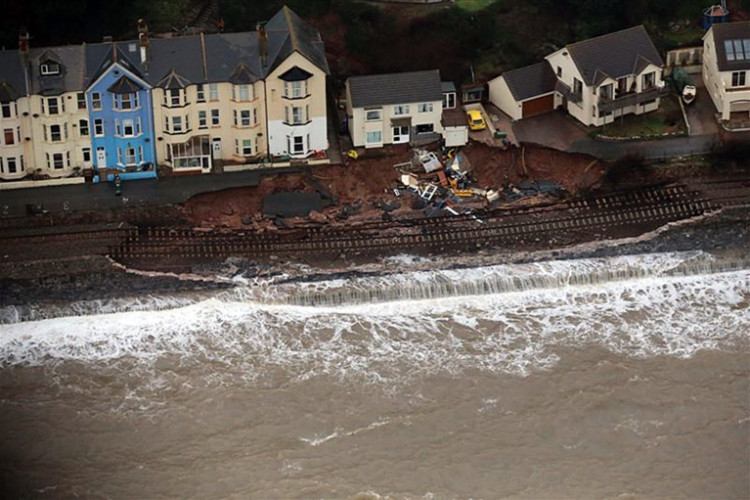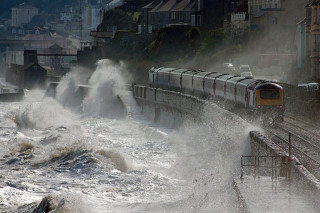Five years ago, violent storms punched a massive hole through sea defences protecting the Devon town of Dawlish, causing a vital stretch of coastal railway to collapse into the sea.
As well as the 100m breach of the sea wall at Riviera Terrace, there were smaller secondary breaches at Dawlish Warren and Teignmouth, and five landslips including a major collapse between Dawlish and Teignmouth which blocked the line with 20,000 tonnes of material.
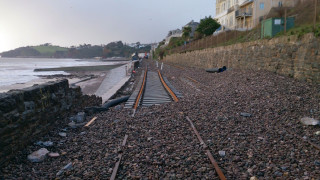
The picturesque stretch of railway from Dawlish westward to Teignmouth is more than just a popular tourist route: it is the only way in and out of Cornwall by rail and is vital to the economy of the south-west.
In just eight weeks following the storm, contractors working for Network Rail had completed emergency repairs and the line re-opened. But it was clear that permanent, and more extensive, reconstruction was required.
With £15m of funding from the Department for Transport, Network Rail set up the South West Rail Resilience Programme to establish the scope of the repairs required and formulate a plan of work.
Specialists in coastal, tunnel, cliff and railway engineering conducted detailed studies along the route between Teignmouth and Dawlish to work out what is happening to the cliffs and coastline, and allow a number of alternative solutions to be established.
Numerous options were considered – including alternative routes away from the sea – but it was ultimately decided to retain and improve the existing route.
“From blank page studies that looked at all options we’ve identified this as the most feasible rail route for Devon and Cornwall and there are areas that specifically need our attention,” said Mark Langman, managing director for Network Rail’s western route.
“Improving the resilience of the sea wall at Dawlish is one of the most immediate and easiest areas we can begin work on and we’ve now submitted detailed plans to Teignbridge District Council.”
In February, Network Rail submitted its plans to Teignbridge District Council for a new, higher sea wall at Dawlish that would provide greater resilience.
Network Rail’s senior commercial scheme sponsor, Julie Gregory, says the new wall would help to avoid disruption to train services following extreme weather. “The bit that’s most vulnerable is the bit we’re addressing first, to the west of Dawlish Station,” she explains.
“That’s called Marine Parade and it’s about a 360m section of sea wall that we’re raising using precast concrete panels. It will make the wall about 2.5m higher.
“We want to do the job once, shore up the railway to protect it through the next century, taking into account sea level rise as a result of climate change,” adds Gregory.
Arup designed the new sea wall and commissioned testing and research specialist HR Wallingford to conduct physical modelling tests in the laboratory to verify the performance of the proposed design.
HR Wallingford’s Coastal Structures Group completed its study in April having spent two months carrying out a series of 2D tests in a 40m-long wave flume. The work involved constructing the bathymetry, calibrating the different sea states for the different bed levels, building a scaled model of the sea wall design, and carrying out tests for different crest level and storm conditions.
Shortly after Network Rail submitted its planning application the government announced that it would release £80m to fund construction of the new sea wall at Dawlish.
Then in April Network Rail’s plans were unanimously approved by Teignbridge District Council’s planning committee, clearing the way for work to commence almost immediately. Main contractor for this phase of the improvements is BAM Nuttall; the new sea wall is expected to be complete by 2021.
Meanwhile the South West Rail Resilience Programme continues to develop solutions for the cliffs along the coast immediately north-east of Teignmouth using the £15m provided by the government in the wake of the 2014 storms.
The rail improvements at Dawlish now form part of a wider programme to improve connectivity throughout the south west region, outlined in the Investing in the South West report, published by the Department for Transport in February 2019.
This identifies schemes totalling more than £2bn in value, improving the strategic road network, new direct bus routes, safe and continuous cycle routes and easier transfer between transport modes.
Transport secretary Chris Grayling said: “We cannot allow the disruption and damage endured by Dawlish and the south-west to happen again. This significant investment demonstrates our cast-iron commitment to delivering a resilient and safe railway, giving passengers, businesses
and residents confidence in a reliable service.

“With up to £80m of funding available to create a rigorous set of defences, this new sea wall will help protect this vital route, building on our ambitious plans to grow this region’s economy and prosperity through stronger transport connections.”
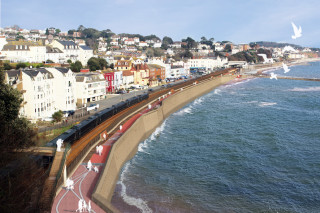
What happened - when storms hit Dawlish
On 4th and 5th February 2014, powerful winds and high seas breached the wall protecting the railway line at Dawlish. A section of the wall, along with 80m of track, sections of platform at Dawlish railway station and part of the coastal path were washed away.
Another storm on 14th February caused a breach of the temporary sea defences (a line of shipping containers). A couple of weeks later, along the coast near Teignmouth, a landslip resulted in 20,000 tonnes of material being washed down from the cliff over the railway and into the sea.
Network Rail’s contractors battled for more than two months in continuing foul weather conditions to repair a 100m breach at Riviera Terrace in Dawlish.
The 2014 response involved:
• Installing a temporary sea wall made from 19 welded shipping containers to prevent further damage
• Rebuilding and fortifying the breach with more than 6,000 tonnes of concrete and 150 tonnes of steel
• Removing about 100,000 tonnes of collapsed cliff at Woodlands Avenue, Teignmouth, following a landslip on 4th March 2014.
• Repairing dozens of other sites along a four-mile stretch of coastal railway, clearing hundreds of tonnes of debris and repairing more than 600m of parapet wall
• Installing over 13 miles of new cables, designing and installing a new temporary signalling system and replacing more than 700m of track and ballast
• Repair and reconstruction at Dawlish station including a new platform, new canopy and repainting.
Contractor Amalgamated Construction (now Amco Giffen) won the contract to carry out emergency repairs by constructing a new 350m masonry wall comprising 96 specially-designed L-shaped retaining wall sections and 152 profiled precast sea-wall units manufactured by Bison Precast Concrete at its Somercotes factory in Derbyshire.
Each of the retaining wall sections was around 3m high and the sea-wall units weighed approximately 15 tonnes apiece.
Phase 1 of the works relied heavily on the rapid production of the 96 retaining wall panels which were installed both behind the parapet seawall and as a retaining wall for the roadway behind. Together they formed a U-shaped channel to support the railway line.
Phase 2 of the works required 152 profiled precast seawall units to replace the 19 steel shipping containers which had been installed as a temporary breakwater following the initial breach.
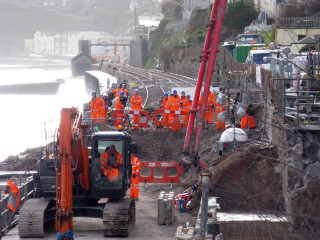
These units were shipped from Teignmouth docks to two barge platforms, the largest equipped with a 160-tonne-capacity crawler crane to lift the units into place on an in-situ slab of fibre-reinforced concrete.
Production of the precast units began just four days after an initial emergency site meeting with Amco, using existing moulds specially adapted for the purpose.
This article was first published in the May 2019 issue of The Construction Index magazine
UK readers can have their own copy of the magazine, in real paper, posted through their letterbox each month by taking out an annual subscription for just £50 a year. Click for details.
Got a story? Email news@theconstructionindex.co.uk

